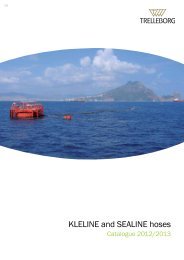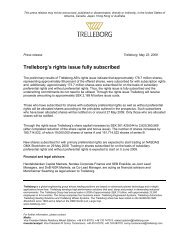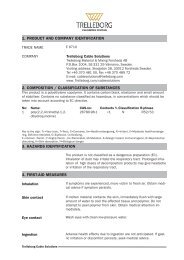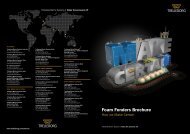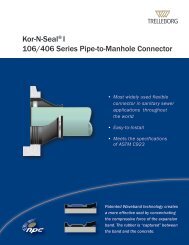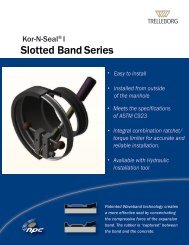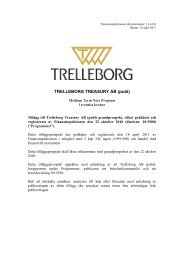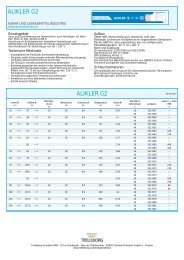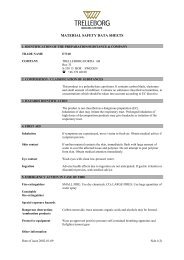Annual report 2011 - Trelleborg
Annual report 2011 - Trelleborg
Annual report 2011 - Trelleborg
Create successful ePaper yourself
Turn your PDF publications into a flip-book with our unique Google optimized e-Paper software.
78<br />
NOTES – GROUP<br />
financial assets is recognized on the transaction date, which is the date the<br />
Group undertakes to purchase or sell the asset. On each closing date, the<br />
Group tests whether any financial asset or group of financial assets has been<br />
impaired.<br />
Classification of financial instruments<br />
The Group classifies its financial instruments into the following categories:<br />
financial assets or liabilities at fair value through profit and loss, loans and<br />
receivables and financial liabilities measured at amortized cost.<br />
The classification depends on the purpose for which the instrument was<br />
acquired. The classification is determined on the initial recognition of the instrument<br />
and is reassessed on each subsequent <strong>report</strong>ing occasion.<br />
Calculation of fair value<br />
The fair value of listed financial instruments is based on the appropriate market<br />
quotation on the closing date. For unlisted financial instruments, or if the<br />
market of a certain financial asset is not active, the value is determined by<br />
applying recognized measurement techniques, whereby the Group makes<br />
assumptions that are based on the market conditions prevailing on the closing<br />
date. Market rates form the basis for the calculation of fair value of long-term<br />
loans. For other financial instruments with no specified market value, the fair<br />
value is deemed to correspond to the carrying amount.<br />
Receivables and liabilities in foreign currencies<br />
Receivables and liabilities in foreign currencies are measured at the exchange<br />
rate prevailing on the closing date. Exchange-rate differences on operating<br />
receivables and operating liabilities are included in operating profit or loss, while<br />
exchange-rate differences on financial receivables and liabilities are classified<br />
as financial items.<br />
Financial assets at fair value through profit and loss<br />
This category comprises both financial assets held for trading and assets designated<br />
in this category from the date of the investment that is to be measured at<br />
fair value through profit and loss. The Group’s assets in this category comprise<br />
non-current and current securities investments and financial derivatives not<br />
identified as hedges. Assets in this category are classified as current assets if<br />
held for trading or expected to be realized within 12 months from the closing<br />
date. Financial assets at fair value through profit and loss are measured at fair<br />
value, both initially and subsequent to the date of acquisition, while associated<br />
transaction costs are recognized in profit and loss. Gains and losses attributable<br />
to changes in fair value are recognized in profit and loss as a financial item<br />
in the period in which they occur.<br />
Financial liabilities at fair value through profit and loss<br />
This category comprises derivatives with a negative fair value that are not used<br />
for hedge accounting and financial liabilities held for trading. The liabilities are<br />
measured continuously at fair value and the change in value is recognized<br />
through profit and loss as a financial item. Only derivatives were recognized in<br />
this category during the year.<br />
Loans and receivables<br />
Loans and receivables are financial assets that are not derivatives with fixed or<br />
determinable payments, and which are not quoted in an active market.<br />
Loan receivables and accounts receivable are initially measured at fair<br />
value and, subsequently, at amortized cost by applying the effective interest<br />
method, less any provisions for impairment. A bad debt provision is established<br />
when there is objective evidence that the Group will not be able to secure all<br />
amounts maturing in accordance with the original conditions of the receivable.<br />
Significant financial difficulties experienced by a debtor, the probability of the<br />
debtor entering into bankruptcy or undergoing financial reconstruction and<br />
payments not being made or being made late (fallen due by more than 30 days)<br />
are all considered to be indications that a bad debt provision may be required.<br />
The size of the provision comprises the difference between the carrying amount<br />
of the asset and the present value of estimated future cash flows, discounted<br />
by the receivable’s effective interest rate. The carrying amount of the asset is<br />
reduced by using a value depletion account and the loss is recognized under the<br />
item “Selling expenses”. When a receivable cannot be collected, it is eliminated<br />
against the value depletion account for receivables. The reversal of amounts<br />
that were previously eliminated is credited under the item “Selling expenses” in<br />
the income statement.<br />
Cash and cash equivalents<br />
Cash and cash equivalents consist of cash balances and balances with banks<br />
and other institutes maturing within three months from the time of acquisition,<br />
as well as short-term investments with a maturity, from the time of acquisition,<br />
of less than three months, and which are exposed to a minimal risk of fluctuations<br />
in value.<br />
Borrowings<br />
Borrowings are initially recognized at fair value, net, after transaction costs and,<br />
subsequently, at amortized cost. Any difference between the amount received<br />
and the amount to be repaid is recognized in profit and loss over the loan period<br />
<strong>Annual</strong> Report <strong>2011</strong> <strong>Trelleborg</strong> AB<br />
by applying the effective interest method. Borrowings are classified as interestbearing<br />
non-current or current liabilities in the balance sheet.<br />
Accounts payable<br />
Accounts payable are initially recognized at fair value and, thereafter, at accrued<br />
cost using the effective interest method.<br />
Offsetting of financial instruments<br />
Financial assets and liabilities are offset and recognized at net amount in the<br />
balance sheet only when a legal right exists to offset the recognized amount<br />
and there is an intention to settle the amount net, or simultaneously realize the<br />
asset and settle the liability.<br />
Impairment of financial assets<br />
Assets carried at amortized cost<br />
At the end of each <strong>report</strong>ing period, the Group tests whether there is objective<br />
evidence to recognize impairment losses on a financial asset or group of financial<br />
assets. Impairment losses will be recognized on a financial asset or group<br />
of financial assets only if there is objective evidence of an impairment requirement<br />
resulting from the occurrence of one or more events after the asset was<br />
initially recognized (a “loss event”) and if this event (or events) has (have) an<br />
impact on estimated future cash flows for the financial assets or group of financial<br />
assets that can be estimated reliably.<br />
Financial derivatives<br />
The Group utilizes derivatives to cover the risk for exchange-rate fluctuations<br />
and to hedge its exposure to interest-rate risks. The Group also uses derivatives<br />
for commercial trade within the framework of the mandates determined by the<br />
Board. Holdings of financial derivatives include interest-rate and currency swaps,<br />
FRAs and foreign-exchange forwards, and interest-rate and currency options.<br />
Derivatives are recognized in the balance sheet from the contract date and<br />
are measured at fair value, both initially and in subsequent remeasurement. The<br />
method for recognizing the gains or losses arising in connection with remeasurement<br />
depends on whether or not the derivatives have been identified as a<br />
hedging instrument and whether this is a hedge of fair value, cash flow or net<br />
investment.<br />
Derivatives not identified as hedging instruments are classified in the<br />
balance sheet as financial assets and liabilities valued at fair value through<br />
profit and loss. Gains and losses resulting from changes in fair value are recognized<br />
as financial items in profit and loss in the period in which they occur.<br />
Hedge accounting<br />
The Group applies hedge accounting for financial instruments intended to hedge<br />
the following financial risks: future commercial cash flows – internal and<br />
external – in foreign currency, cash flows in future interest payments on the<br />
Group’s borrowing and net investments in foreign operations.<br />
When entering into the transaction, the relationship between the hedging<br />
instrument and the hedged item or transaction is documented, as is the objective<br />
of risk management and the strategy according to which various hedging<br />
measures are implemented. Both at the inception of the hedging transaction<br />
and on an ongoing basis, the Group also documents its assessment as to<br />
whether or not the derivatives used for the hedging transaction are efficient in<br />
terms of offsetting changes in the fair value of the hedged items or in terms of<br />
the cash flows pertaining to them.<br />
Hedges are designed so that they can be expected to be effective. Changes<br />
in the fair value of such derivatives not meeting the requirements for hedge<br />
accounting are recognized directly in profit and loss.<br />
Hedging of future commercial cash flows in foreign currencies<br />
To hedge future forecast and contracted commercial cash flows, both within the<br />
Group and externally, the Group secures foreign-exchange forward contracts and<br />
currency option contracts. The effective portion of changes in the fair value of<br />
hedging instruments is recognized in other comprehensive income.<br />
The gain or loss attributable to any ineffective portion is recognized directly<br />
in operating profit in profit and loss. Accumulated amounts in equity are transferred<br />
back to profit and loss in the periods in which the hedged item affects<br />
profit, such as when a forecast external sale takes place.<br />
When a hedging instrument expires or is sold, or when the hedge no longer<br />
meets the requirements for hedge accounting, accumulated gains or losses<br />
remain in equity and are recognized as income/loss at the same time as the<br />
forecast transaction is finally recognized in profit and loss.<br />
If a forecast transaction is no longer expected to take place, the accumulated<br />
gain or loss recognized in equity is immediately transferred to profit and<br />
loss.<br />
Hedging of cash flows in future interest payments on Group borrowing<br />
The Group secures interest-rate derivatives to ensure the required interest rate<br />
on the Group’s net borrowings. Amounts to be paid or received in relation to<br />
interest-rate derivatives are recognized on an ongoing basis as interest income<br />
or interest expense.<br />
Changes in the fair value of hedging instruments are recognized in equity<br />
until the maturity date. Any ineffective portion is recognized directly in profit and




